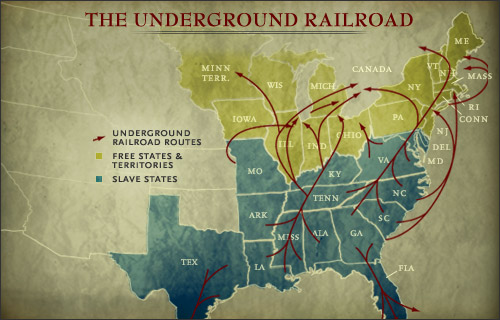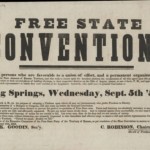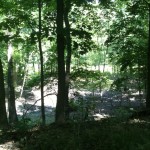In the late summer of 1851, Bazil Simpson, a North Carolina-born resident of Pike County, led a raid against slave catchers who had traveled to Dongola, Indiana, in search of their bounty. Simpson and his accomplices found and stole the horses of the slave hunters, as they laid in wait at the Dongola bridge. Simpson and his party attached fuses and flammable material to the horses’ tails and drove them, tails lit, across the bridge. Or so the story goes.
Historians have hotly contested the history of the Underground Railroad in Indiana; they do, however, largely agree that 3 major “trunk lines” of the railroad led escapees and their guides through the state. None of these routes included Dongola, a town platted in 1851 by Willard (a.k.a. William) Carpenter and Issac Street (a.k.a. Steele) just downriver from the point where the Wabash and Erie Canal aqueduct crossed the Patoka River. The town sprang up amidst a canal-building boom; boosters promised growth in trade and industry for local residents.
Shortly before Dongola’s founding, the federal government had passed the 1850 Fugitive Slave Act, which generated animosity from local residents who resented the institution of slavery and especially the potential for its expansion into free states. Most of those who actively opposed the act did so not out of any desire for racial equality, but out of self-interest—slave labor represented a threat to white wage-earners.
One figure remembered for his alleged anti-slavery work is James Cockrum, whose son William published History of the Underground Railroad in 1915. In the book, William tells stories about the attempts of his father and a group of other local men—town founders Carpenter and Street among them—to foil bounty hunters searching for escaped slaves. In one instance, James and his accomplices, who included five free black activists, are said to have branded captured kidnappers with the sign of the cross. In another, they allegedly cut off their captives’ left earlobes to mark them permanently as slave catchers.
Cockrum’s History includes thirty-three incidents of Underground Railroad activity involving residents of Gibson and Pike Counties. Of those, Dongola figures in fifteen. Perhaps the large community of transient laborers made the growing town ideal for someone in need of brief anonymity. The physical landscape would have provided perfect cover for those who could knew and could navigate such treacherous terrain.
Historians have denied the credibility of Cockrum’s history, which was based largely on boyhood memories. Truthful, apocryphal, or entirely invented, these stories, some of which have survived to this day amongst residents of the area, tell us something about the rich histories that everyday landscapes can hold and reveal much about the ways in which people have remembered and continue to remember a complex past.
Source: Edith Sarra, “Troubled Crossings: Local History and the Built Environment in the Patoka Bottoms,” Indiana Magazine of History (March 2013)
A Moment of Indiana History is a production of WFIU Public Radio in partnership with the Indiana Public Broadcasting Stations. Research support comes from Indiana Magazine of History published by the Indiana University Department of History.























